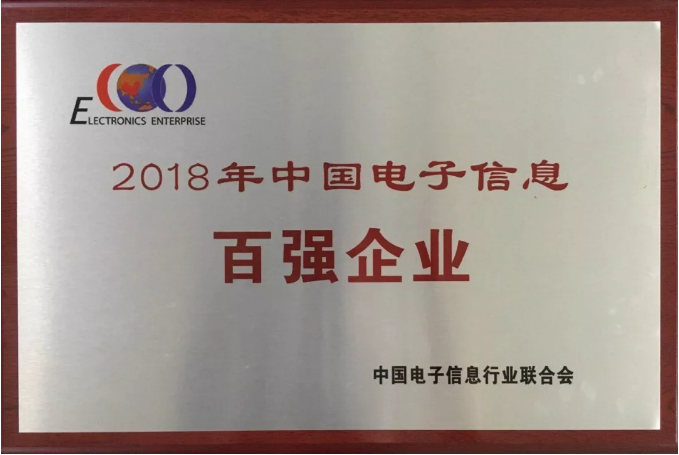
The 2018 China Top 100 Electronic Information Enterprises Release Conference was held in Changchun on July 31. Vice President and Secretary General of the China Electronic Information Industry Association Zhou Zixue announced the new list of Top 100 Chinese Electronic Information Enterprises (known as the Top 100 Enterprises).
The Jiangsu Xinchao Technology Group ranked 35th.


Scale Further Expanded
This year's Top 100 achieved a total business revenue of RMB 3.5 trillion, a 16.7% increase from the previous year. Total assets reached RMB 4.4 trillion, up 10%.
Revenue for each of the top three companies exceeded RMB 200 billion, with 10 companies bringing in revenue of over RMB 100 billion, an increase of 4 over last year, 66 companies surpassing RMB 10 billion, an increase of 8.
The lowest business revenue to make the list was RMB 5.04 billion, up RMB 680 million over last year.
Profitability Further Improved
The top 100 enterprises achieved a total profit of RMB 224.9 billion this year, a 20.5% increase over the previous year, surpassing the revenue growth rate by 3.8 percentage points. The average profit margin of the top 100 enterprises was 6.4%, up 0.2 percentage points over the previous year and 0.9 percentage points above the industry average.
The average accounts receivable turnover ratio for these enterprises was 5.6, with an inventory turnover period of 35 days. The debt-to-asset ratio stood at 66.0%, with an interest coverage ratio of 6.1. All performance indicators are industry-leading.
Enhanced R&D Capabilities
The top 100 enterprises collectively invested RMB 219.4 billion in research and development, a 16% increase over the previous year, keeping pace with revenue growth. The average R&D investment intensity reached 6.3%, exceeding the industry average by over 2 percentage points.
The total number of R&D personnel reached 450,000, an increase of 60,000 over the previous year, 22.1% of the total workforce.
By the end of 2017, the top 100 enterprises held a total of 341,000 patents, an increase of 34,000 over the previous year. Among these, 261,000 were invention patents, an increase of 72,000, with invention patents accounting for 76.6%.
Among the top ten companies in terms of invention patents granted in China for 2017, Huawei, BOE, ZTE, Lenovo, and SMIC ranked 2nd, 4th, 5th, 6th, and 10th, respectively.
Deepening Multinational Operations
In 2017, the top 100 enterprises achieved an export volume of RMB 773.7 billion, 18.4% of the industry's total exports.
Of these, 19 companies had export volumes exceeding RMB 10 billion, and 22 companies had overseas market revenues accounting for more than 50% of their total income.
As the scale of product exports expands, these top enterprises are leading the international influence of Chinese brands and their position in the global division of labor.
In terms of brand influence, according to the 2017 Top 30 Chinese Brands Going Global list, companies like Lenovo and Xiaomi have expanded the international influence of Chinese brands through innovative digital devices and services. At the 2018 CES, Chinese brands accounted for over 30% of the exhibitors, with Huawei, ZTE, TCL, and Skyworth competing alongside Google, Amazon, and NVIDIA.
In terms of international division of labor, top enterprises such as Huawei, Xiaomi, Hisense, and Hikvision are continuously improving their products and services in mobile phones, color TVs, and artificial intelligence, significantly enhancing their international standing.
In the telecommunications sector, the 5G network architecture developed by these top enterprises has become an international standard, positioning them as potential global leaders in the next generation of mobile communication.
Accelerated Strategic Transformation
The top 100 companies are actively responding to the national "Two Strong Nations" strategic plan, continuously accelerating their transformation and upgrading.
1. Strengthening core foundations: Huawei has developed the Kirin 970 smart chip, and domestic CPUs such as those from Phytium, Loongson, and Zhaoxin have shown continuous performance improvements. BOE has achieved mass production of its first flexible screen production line, ending foreign monopoly. Additionally, fundamental products like battery separator materials, micro-electromechanical system sensors, and graphene have also broken the foreign monopoly, addressing several "bottleneck" issues.
2. Advancing towards high-end, intelligent products: Market penetration for smartphones and smart TVs has surpassed 80%. The variety of emerging products, such as smart wearable devices, smart home products, and virtual reality devices, continues to expand. In emerging fields like VR/AR, autonomous driving, artificial intelligence, and drones, the technologies and applications of these top 100 companies are leading globally.
3. Focusing on emerging fields and future technological frontiers: New technologies including cloud computing, big data, industrial internet, and artificial intelligence are being rapidly promoted and applied. The development and commercialization of cutting-edge technologies like 5G, next-generation internet, ultra-high-speed large-capacity optical transmission, and quantum communication are accelerating.
Enhanced Sense of Responsibility
The top 100 companies have further increased their economic and employment impacts. This year, they achieved a total tax amount of RMB 137.8 billion, a 17% increase over the previous year. The total number of employees reached 2.05 million, an increase of 210,000 from the previous year. Taxes and employees account for over 60% and 15% of the industry total, respectively.
In addition, these top companies are actively assuming various social responsibilities.
In 2017, nearly 80% of the top 100 companies released social responsibility reports and directly donated over RMB 2 billion to various public welfare causes.
Over thirty years, the top 100 companies in the electronic information industry have grown from small to large and from weak to strong. They have undergone extensive transformations in economic structure, market structure, and product and service structure, achieving comprehensive upgrades in scale, efficiency, technology, and brand. They have played a significant role in leading industry healthy development and supporting economic and social transformation.
In the new era, the top 100 companies should actively seize new policy and market opportunities, strengthen independent innovation, accelerate the application and promotion of new technologies, strategically plan and position themselves, and explore pathways for high-quality development. Their efforts will contribute to achieving the strategic goals of becoming a global manufacturing power and a leading network power.